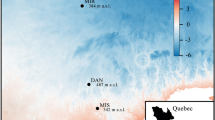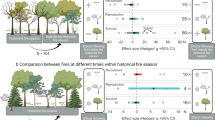Abstract
In many temperate ecosystems succession from pine forest to hardwoods is interrupted by fire, resulting in a fire climax dominated by pines1–3. As natural selection operates through both processes of succession and fire, early serai plants that are poor competitors may exhibit fire-facilitating characteristics whereas late serai plants that are superior competitors may show fire-retarding traits. Potential fire-retarding and fire-facilitating traits of plant foliage have been measured4–7, but then- effects on survival or reproduction have never been demonstrated in the field7,8. We report here that maximum temperatures, recorded during fires in a mixed oak-pine woodland, were sufficiently higher under pines than under oaks to ensure elimination of the competitively superior oaks in the vicinity of adult pines.
This is a preview of subscription content, access via your institution
Access options
Subscribe to this journal
Receive 51 print issues and online access
$199.00 per year
only $3.90 per issue
Buy this article
- Purchase on Springer Link
- Instant access to full article PDF
Prices may be subject to local taxes which are calculated during checkout
Similar content being viewed by others
References
Spurr, S. H. & Barnes, B. V. Forest Ecology (Wiley, New York, 1980).
Harper, R. M. Proc. Tall Timbers Fire Ecology Conf. 1, 11–29 (1962).
Wahlenberg, W. G. Longleaf Pine (Charles Lathrop Pack Forestry Foundation, Washington D.C., 1946).
Mount, A. B. Aust. Forester 28, 166–172 (1964).
Jackson, W. D. Proc. ecol. Soc. Austr. 3, 9–16 (1968).
Mutch, R. W. Ecology 51, 1046–1051 (1970).
Gill, A. M. USDA Forest Service Gen. Tech. Rep. WO-3 (1977).
Dobzhansky, T. Am. Nat. 90, 337–347 (1956).
Laessle, A. M. Ecol. Monogr 28, 361–387 (1958).
Garren, K. H. Dot. Rev. 9, 617–654 (1943).
Veno, P. Ecology 57, 498–508 (1976).
McCarthy, E. F. & Sims, I. H. J. For. 33, 155–157 (1935).
Van Wagner, C. E. Can, J. For. Res. 3, 373–378 (1973).
Whittaker, E. J. Ecol. 49, 709–715 (1961).
Hopkins, B. J. appl. Ecol. 2, 367–381 (1965).
Albini, F. A. USDA Forest Service Gen. Tech. Rep. INT-30 (1976).
Harper, J. L. Population Biology of Plants (Academic, New York, 1977).
Kimmins, J. P. J. Zool. 49, 1005–1011 (1971).
Author information
Authors and Affiliations
Rights and permissions
About this article
Cite this article
Williamson, G., Black, E. High temperature of forest fires under pines as a selective advantage over oaks. Nature 293, 643–644 (1981). https://doi.org/10.1038/293643a0
Received:
Accepted:
Issue Date:
DOI: https://doi.org/10.1038/293643a0
This article is cited by
-
Modeling spatial patterns of longleaf pine needle dispersal using long-term data
Fire Ecology (2023)
-
Longleaf pine proximity effects on air temperatures and hardwood top-kill from prescribed fire
Fire Ecology (2019)
-
Forest litter and shrubs act as an understory filter for the survival of Quercus mongolica seedlings in Mt. Kwan-ak, South Korea
Scientific Reports (2019)
-
Fire effects on a fire-adapted species: response of grass stage longleaf pine seedlings to experimental burning
Fire Ecology (2018)
-
The role of succession in the evolution of flammability
Theoretical Ecology (2018)
Comments
By submitting a comment you agree to abide by our Terms and Community Guidelines. If you find something abusive or that does not comply with our terms or guidelines please flag it as inappropriate.



